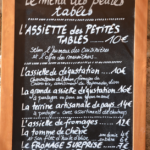
Who knew that restaurant menu words can impact the price of a dish? And, every letter counts. Author Dan Jurafsky wrote the book The Language of Food: A Linguist Reads the Menu. I was fascinated to learn that every increase of one letter in the average length of words describing a dish is associated with an increase of 18 cents in the price of that dish. Who knew? Delicious steak costs more than tasty steak.
What Jurafsky did was to examine 650,000 dishes in seven US cities. That’s a lot of words. What he found was that more complex words convey value.
You’ve probably seen “Filler words” — such as tasty, mouthwatering, scrumptious, zesty, rich, golden-brown, crispy, crunchy, ripe and real on mid-priced menus, not the expensive multi star high end restaurant menus. Why?
He thinks it’s because a diner needs more assurance in a less expensive place. The diner will wonder, “Will the food be good? Or not?” You don’t have those doubts in an upscale place.
Another persuasive element in restaurant menus is choice. The more upscale–the less choice you have. You’re getting to choose from fewer items that the chef recommends. In lower scale restaurants you are in command and there’s far more to choose from.
You can read more about the work on persuasion and menus. And, bon appetit!